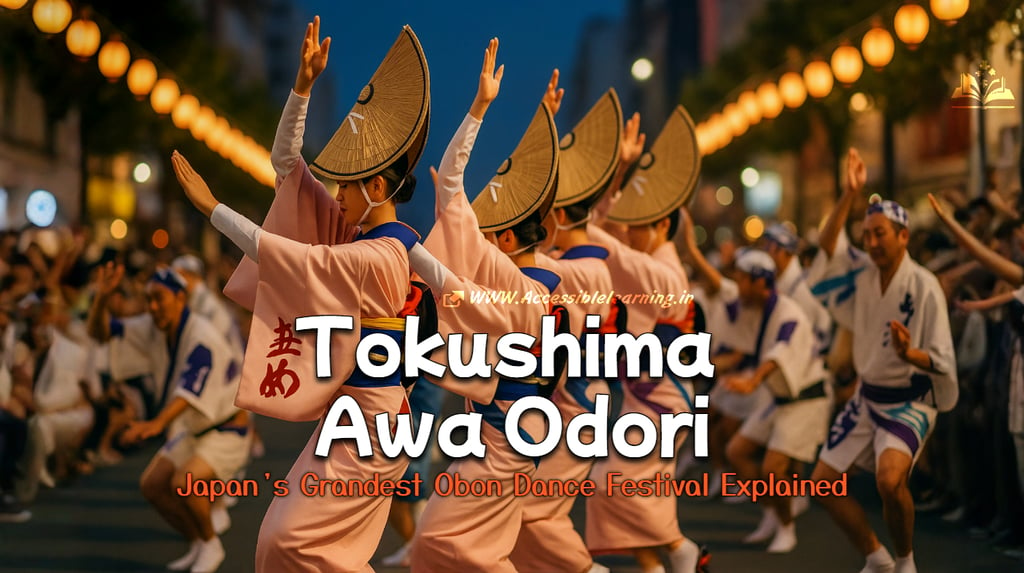
Tokushima Awa Odori: Japan’s Most Joyous Dance Festival of the Obon Season
Tokushima Awa Odori is Japan’s most famous traditional dance festival, held every August in Tokushima Prefecture during Obon. With 400+ years of vibrant history, it features hypnotic rhythms, colorful costumes, and joyful street parades. In this guide, discover the origins, dance styles, music, ren troupes, local food, and insider travel tips to experience Awa Odori like a local.
CULTURE/TRADITIONEVENT/SPECIALTRAVEL LIFESTORY/ENTERTAINMENTJAPAN
Kim Shin
8/6/20253 min read


The Soulful Pulse of Tokushima
Held every August in Tokushima City, Awa Odori (阿波おどり) is not just a festival—it's an electrifying expression of joy, rhythm, and community spirit that pulses through the heart of Shikoku Island. As part of the nationwide Obon celebrations, where spirits of ancestors are welcomed back home, Awa Odori transforms Tokushima into a stage where tradition and modernity dance hand in hand. With over 400 years of history, the streets come alive with coordinated dancers, shamisen music, and the chorus of “Yatto-sa, yatto-yatto!”
Origins & Cultural Significance
Awa Odori traces back to the late 16th century during the feudal era, believed to have begun in 1586 to celebrate the completion of Tokushima Castle. Legend suggests that locals, after enjoying sake gifted by the daimyo, began dancing and singing in an unrestrained manner—giving birth to this exuberant tradition. Over time, this evolved into a stylized and choreographed performance, deeply rooted in Buddhist rituals of Obon—honoring the spirits of the dead through joyous expression rather than mourning.
Today, Awa Odori symbolizes unity, remembrance, and the celebration of life itself.
The Dance: “The Fool Dances, and the Fool Watches”
Awa Odori is characterized by its iconic chant:
“Odoru ahou ni miru ahou, onaji ahou nara odoranya son son!”
(“The dancers are fools. The watchers are fools. If both are fools, you might as well dance!”)
This line captures the spirit of Awa Odori perfectly—everyone is encouraged to join, dance, and shed inhibitions. The dance involves two major styles:
Men’s Dance (Otoko Odori): Energetic, exaggerated movements with deep stances and flared legs.
Women’s Dance (Onna Odori): Graceful, upright postures in yukata with straw hats (amigasa) and raised arms moving in rhythm.
Both styles are performed by ren—dancing troupes composed of locals, students, professionals, and even corporate teams.
Music and Instruments: A Hypnotic Harmony
The backbone of Awa Odori is its music, known as narimono, performed live by troupes:
Shamisen: A Traditional string instrument setting the melody.
Taiko Drums: Driving rhythm and base energy.
Fue (bamboo flute): Melodic overlays.
Kane (bells): Accentuate beats and transitions.
Together, these instruments create a trance-like rhythm that makes the dance both meditative and electrifying.

When and Where to Experience Awa Odori
Main Festival Dates: August 12–15
Location: Downtown Tokushima City (Shinmachi and Aibahama areas)
Festival Zones
Paid Performance Areas (Enbujo): Grandstands where professional ren perform choreographed routines.
Free Street Zones (Nagashi Odori): Open streets for both dancers and viewers—great for spontaneous participation!
Dance Stages (Hiroba): Cultural exhibitions, contests, and youth groups performing.
Pro Tip: Visit the Awa Odori Kaikan Museum (open year-round) for historical exhibits and even daily mini-performances.
Travel Guide: Getting There & Staying Smart
Access
From Tokyo or Osaka, take the Shinkansen to Okayama, then transfer to the JR Seto-Ohashi Line to Tokushima Station.
Alternatively, flights to Tokushima Awaodori Airport are available from major cities.
Accommodation Tips
Book early—hotels fill up months in advance.
Nearby cities like Naruto or Takamatsu can serve as overflow options.
What to Wear
Yukata or light summer clothes. Many tourists rent traditional attire to join the fun.
Etiquette
Don’t hesitate to dance! Locals welcome audience participation.
Respect designated areas and follow directions from festival staff.
Photography is allowed, but be mindful of performers' space.
Types of Ren (Dance Troupes)
There are over 1,000 “ren” troupes, each with distinct dance styles, costumes, and musical interpretations. These fall into different categories:
Famous/Professional Ren: Groups like Arudeyo Tokushima Ren and Uchikubi Gokumon Doukoukai are crowd favorites with theatrical flair and precise choreography.
Amateur Ren: Open to locals, tourists, and newcomers. Many encourage participation even with minimal experience.
Corporate/Community Ren: Formed by local companies or neighborhoods to showcase teamwork and regional pride.
Night vs. Day Performances
Awa Odori is truly a festival of contrasts between day and night:
Daytime Events (around 11 AM – 4 PM): Often include cultural exhibitions, dance workshops, and children’s performances.
Night Parades (6 PM – 10:30 PM): Streets glow with lanterns, dancers wear illuminated costumes, and the atmosphere turns electric.
Local Foods & Festival Specialties
No festival is complete without indulging in Tokushima’s culinary delights:
Sudachi Citrus Drinks: Refreshing and tart, often served chilled—perfect for summer.
Tokushima Ramen: Rich pork broth, raw egg topping, and firm noodles—ideal for a post-dance meal.
Awa Odori Chicken: A local specialty of juicy, flame-grilled free-range chicken with crispy skin.
Yuzukosho Skewers: Spicy citrus pepper paste glazed over grilled meats and vegetables.
Why You Should Experience Awa Odori at Least Once
Awa Odori is more than a visual spectacle—it’s a transformative cultural experience. Whether you dance or just watch, the atmosphere is overwhelmingly inclusive and joyful. It captures the Japanese philosophy of ichigo ichie—cherishing each unique moment. The energy, smiles, and harmony between tradition and spontaneity are rare even in Japan's vast festival calendar.
A visit to Tokushima during Awa Odori is a deep dive into Japan’s festive soul. It’s where centuries-old traditions meet unfiltered human expression, where laughter echoes louder than words, and where strangers dance as one. For travelers seeking authentic cultural immersion wrapped in rhythm and color, Awa Odori is not to be missed.
Subscribe To Our Newsletter
All © Copyright reserved by Accessible-Learning Hub
| Terms & Conditions
Knowledge is power. Learn with Us. 📚


